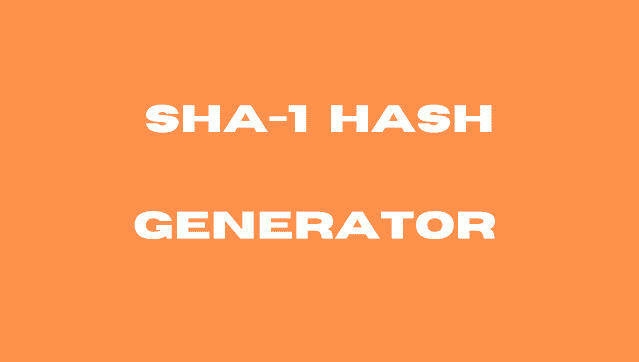In the present speedy advanced world, information security is of vital significance. The SHA-1 (Secure Hash Calculation 1) generator is a strong cryptographic device that assumes an urgent part in defending information uprightness and credibility.
In this article, we will investigate the details of the SHA-1 generator, understanding its importance, how it works, and its applications across different fields.
SHA-1 is a broadly utilized cryptographic hash capability intended to take an information message and produce a fixed-size yield hash esteem, commonly addressed as a grouping of hexadecimal digits.
Figuring out SHA-1: The Essentials
SHA-1 is a broadly utilized cryptographic hash capability intended to take an information message and produce a fixed-size yield hash esteem, commonly addressed as a grouping of hexadecimal digits.
The subsequent hash is exceptional to each information, making it for all intents and purposes difficult to figure out the first message from the hash.
The operation of the SHA-1 generator involves several steps:
Message Padding: SHA-1 takes the information message, Padding it to a particular length, and breaks it into reasonable blocks.
How SHA-1 Works
The operation of the SHA-1 generator involves several steps:
Message Padding: SHA-1 takes the information message, Padding it to a particular length, and breaks it into reasonable blocks.
Instating Hash Values:
The calculation introduces five 32-bit hash esteems (A, B, C, D, E) as constants.
Main Loop:
The input message blocks are processed through several rounds of bitwise operations and logical functions, mixing the data in a complex manner.
Last Hash Worth: After all blocks are handled, the five hash values are linked to frame the last SHA-1 hash.
Last Hash Worth: After all blocks are handled, the five hash values are linked to frame the last SHA-1 hash.
Significance of SHA-1
Data Integrity:
SHA-1 ensures data integrity by generating a unique hash for each message.
Indeed, even a minor change in the first message brings about a tremendously unique hash, making clients aware of any altering or debasement.
Indeed, even a minor change in the first message brings about a tremendously unique hash, making clients aware of any altering or debasement.
Digital Signatures:
SHA-1 is instrumental in creating digital signatures, which are fundamental for checking the validity of advanced records and messages. Digital signatures, empower secure correspondence and approve the shipper's personality.
Password Storage:
Many systems use SHA-1 to store passwords securely.
Rather than putting away plaintext passwords, the hashed stores their hashed variants, protecting client qualifications in the event of an information break.
Rather than putting away plaintext passwords, the hashed stores their hashed variants, protecting client qualifications in the event of an information break.
Blockchain Innovation:
SHA-1 is basic to blockchain innovation, guaranteeing the respectability of each block in the chain and getting the whole decentralized network.
In spite of its boundless use, SHA-1 isn't without difficulties and constraints. Over the long haul, cryptanalysts have found weaknesses in SHA-1, making it vulnerable to impact assaults.
Challenges and Limitations
In spite of its boundless use, SHA-1 isn't without difficulties and constraints. Over the long haul, cryptanalysts have found weaknesses in SHA-1, making it vulnerable to impact assaults.
An impact happens when two distinct sources of info produce a similar hash, compromising the calculation's honesty. Accordingly, SHA-1 is being deliberately transitioned away from safer hash capabilities like SHA-256 and SHA-3.
As innovation progresses, the requirement for more grounded cryptographic calculations becomes clear.
Future-proofing with Advanced Hash Functions
As innovation progresses, the requirement for more grounded cryptographic calculations becomes clear.
For upgraded security, associations and engineers are changing to SHA-256 and SHA-3, which deal with expanded protection from impact assaults and give a more elevated level of trust in information respectability.
The SHA-1 generator has been a foundation of information security for a really long time, offering fundamental cryptographic types of assistance in different applications.
Conclusion
The SHA-1 generator has been a foundation of information security for a really long time, offering fundamental cryptographic types of assistance in different applications.
Its capacity to produce one-of-a-kind hashes guarantees information honesty, computerized marks, and secure secret phrase stockpiling.
Be that as it may, with the rise of safer hash capabilities, it is pivotal for people and associations to change to SHA-256 and SHA-3 for future-sealing their information safety efforts.
As we explore the steadily advancing computerized scene, the significance of hearty cryptographic instruments can't be put into words.
As we explore the steadily advancing computerized scene, the significance of hearty cryptographic instruments can't be put into words.
The SHA-1 generator has served us well, however presently time to embrace fresher innovations that will better shield our information and guarantee a safer computerized future.


.png)


.png)
.png)
.jpg)
.png)
.jpg)
.png)
.png)


0 Comments